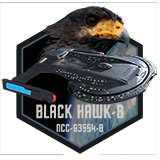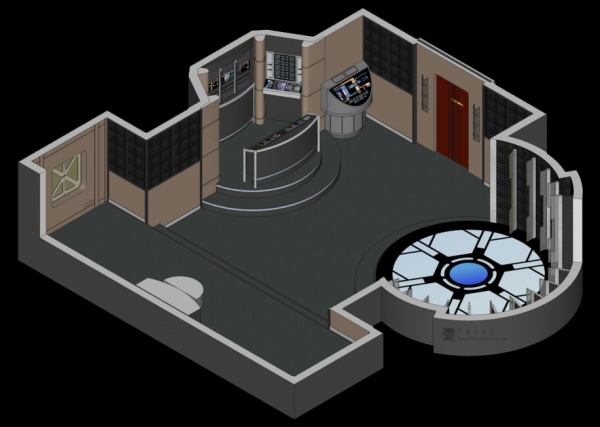The Black Hawk possesses four Transporter Rooms for personnel.
Details
The most commonly used type of transporter is the personnel transporter, designed primarily for starship personnel.
Personnel transporter rooms usually consisted of an operation console, a transporter platform with an overhead molecular imaging scanner, primary energizing coils and phase transition coils. A pattern buffer with a biofilter is located on the deck below the room. The outer hull of a starship incorporated a number of emitter pads for the transporter beam. Personnel transporters work on the quantum level and employed Heisenberg compensators to enable secure transport of lifeforms. Biofilters that were built into the transporter systems prevent dangerous microorganisms from boarding the ship.
The personnel transporter is a reliable, but sometimes fragile piece of equipment. The phase coils in particular are vulnerable to feedback patterns and can be severely damaged as result of power surges or low-level phaser fire.
Technology
The transporter is a device capable of almost instantaneously moving an object from one location to another. Transporters are able to dematerialize, transmit and reassemble an object. The act of transporting is often referred to as "beaming." It was invented by Emory Erickson sometime prior to 2139.
A typical transport sequence for the beam-down of a person begun with a co-ordinate lock during which the destination was verified and programmed, via the targeting scanners. Next, the lifeform to be beamed was scanned on the quantum level and simultaneously converted to a matter stream. This process was determined by an annular confinement beam (ACB). The matter stream was briefly stored in the pattern buffer tank while the system compensated for doppler shift to the destination and then transmitted through an emitter pad. Finally, the person was reassembled at the destination.
Transporters were used by most spacefaring civilizations for short-range transport of personnel or equipment. The main advantages of this form of transport were twofold: On a planetary scale small vehicles or spacecraft were no longer needed to go from one place to another; someone who lived in San Francisco could beam to Paris in the morning and be home for dinner at the end of the day.
Traveling by transporter was almost instantaneous; when beaming from Paris at 16:30 hours one would be home in San Francisco a few seconds later. The sense of time while transporting was almost nonexistent. Compare this to 21st century travel when it took roughly 10 to 12 hours to travel from Paris to San Francisco by airplane. Harry Kim transported frequently from Starfleet Academy to visit his parents in South Carolina.
Diagnostic and maintenance tools
- Synchronic meter
- Magneton scanner
- Micro-resonator
- Safety protocols and components
As with other Starfleet operations the transporter had its own safety protocols to ensure a safe usage. In case of emergency most of these protocols could be turned off or cirumvented.
Biofilters
Biofilters are uniformly used on all Federation transporters by the 24th century. The filter was always functional to prevent the boarding of strange biological entities such as a viruses and pathogens, as well as some forms of radiation including theta radiation.
Biofilters, however were not capable of intercepting the psychic energy of lifeforms and in several instances this has allowed hostile entities to gain access to starships and crew. Biofilters were also unable to detect living organisms that existed within the phased reality of the transporter but once altered could be used to lock onto such lifeforms.
Additionally pattern buffers are used to compensate for relative motion during transport, ensuring that transported matter materializes in the correct location.
Further protocols include prohibitions on beaming while traveling at warp speed and the use of security scans were used to detect weapons or remat detonators which could be disabled before rematerialization.
Limitations
Shields
In general, Transporters could not be used while the deflector shield system of a ship was active, or a deflector shield was in place over the destination. However, it was possible to take advantage of EM "windows" that were created by the normal rotation of shield frequencies. During these peroids, a hole was opened where a transporter beam could punch through. This timing must be absolute and usually requires substantial computer assistance. This technique was theorized and first practiced in 2367 by USS Enterprise-D Transporter Chief Miles O'Brien.
The limitation of transporters versus shields is not universal, however. The Aldeans were able to pass through their own shielding using transporters, though the shielding was impenetrable to other forms of the technology and weapons. Similarly, both the Borg and Dominion used transporter technology that was able to penetrate standard Federation shielding. Some adaptations, including rotating shield frequencies, could inhibit this ability but not eliminate it altogether.
Warp speed
Transporters were not allowed to be used while a ship was at warp speed because of the severe spatial distortions caused by its warp field. Transport at warp was highly dangerous and had been attempted safely only a handful of times. There were however ways to circumvent this limitation.
If both ships maintained exact velocity (i.e. the warp field on both vessels must have the same integral value/factor) transport at warp speed was possible. Failure to maintain the same velocities would result in severe loss of the Annular confinement beam and pattern integrity.
If the ship was traveling at warp speed and the object to be beamed was stationary, transport was possible by synchronizing the ACB with the warp core frequency. The most difficult part was to get a good pattern lock. The Maquis used this method before.
Near-warp transport was also possible, but required extensive adjustments to the transport procedure. Persons who had experienced this form of transport remarked that there was a sensation of being merged with an inanimate object briefly before the transporter beam reassembled them.
Range
The 24th century transporter maximum range was about 40,000 km. Many 24th century starships were equipped with an emergency transporter system, but these only had a range of at best ten kilometers.
Radiation and Substances
Some forms of radiation and substances, usually minerals such as kelbonite, prevent transporters from working. In most instances the interference is caused by scattering of the annular confinement beam or sensor interference preventing a transporter lock. Interference can be natural or artificial and usually occurs during surface-to-starship transport but may also occur between vessels. Examples of other radiation and substance limitations are:
- Magnasite
- Thoron radiation
- Dampening field
- Ionic interference
- Hyperonic radiation
- Electromagnetic storm
Devices
Over the centuries numerous devices have been designed to overcome some limitations of transporters, and still others to intentionally interfere with transporters. By the 24th century usage of pattern enhancers was common aboard most Starfleet vessels, most often deployed to a planet's surface during emergency situations where transport was critical.
Devices that were specifically designed to block transporter signals or to interfere with them were usually deployed under hostile conditions. Thus making use of a transporter impossible or very dangerous and hampering maneuverability of personnel or material. Some of these devices were:
- Transporter scrambler
- Remat detonator
Special Operations
Disabling Active Weapons
To prevent accidental injury to personnel or damage to equipment, the transporter had the capability to disable any weapon active during transport. This could be accomplished by removing the discharged energy from the transporter signal.
Connecting two transporters
When necessary transporters could be bridged. This meant that two transporters could be connected to each other in the event beaming was not possible due to ionic or some other type of interference. The transport duration was twice as long and the sequence differed from a normal transport. First a remote link to the other transporter had to be established, then the system interlock needed to be engaged and the pattern buffers of both transporters were synchronized. When the phase transition coils were in stand-by mode energizing could commence. A side-effect of this form of transport might be that the person who was beamed might feel a slight tingling due to static.
"Site-To-Site" Transport
The earliest example of site-to-site transport was in 2286, a Klingon vessel stolen by the crew of the late starship Enterprise had site to site transporter capabilities.
By 2364, limitations in pattern buffer and targeting scanner technology had been sufficiently overcome that it was now possible to transport from one location directly to another without the need to rematerialize the subject in between. This operation was enabled and controlled by the site-to-site
transport interlocks. Site to site transport holds the matter stream in the pattern buffer while the ACB was re-targeted. Afterwards, the matter stream was redirected to the new location and normal rematerialzation was carried out. This procedure was particularly useful in emergency medical situations where time is of the essence. Subjects could be beamed directly to sickbay where treatment could be carried out quickly. Using this technique, any computer terminal with access to the main transporter sub-systems or any applicable sub-routine could be used to control transporter operations, including bridge terminals. This technique could only be utilized when sufficient source energy is available to the transporters, all normal transporter limitations would still apply. Even given this technique, the transporter rooms were still an important staging and reception area with the greatest amount of override and emergency operations available. Transporter rooms were maintained and manned during all normal duty cycles.
Transporter Trace
A transporter trace was a stored copy of a subject's molecular pattern as scanned during a normal transporter cycle. While it is usually stored for security purposes, in extreme situations the transporter could be modified to use an older trace pattern in place of the latest scan for the purpose of reconfiguring the matter stream during molecular conversion, effectively replacing a subject with an younger version of itself during matter re-construction. This technique was devised by Chief Miles O'Brien and Lieutenant Geordi La Forge during a mission to the Darwin Genetic Research Station in 2365. The transporter trace itself would be stored for the duration of the persons tour of duty, when reassigned the trace would be deleted.
Locations
- Deck 4: Transporter Rooms 1 and 2
- Deck 6: Transporer Rooms 3 and 4
| USS BLACK HAWK TOUR • COMPLETE DECK LISTING | |
| KEY LOCATIONS | Main Bridge • Main Conference Lounge • Sickbay • Flight Deck • Main Engineering • Security Complex |
| SECONDARY LOCATIONS | Captain's Ready Room • XO's Ready Room • Brig • Armory • Mess Hall • Cargo Bays • Transporter Room Science Labs • Auxiliary Control • Chief Counselor's Office • Chief Operations Officer's Office Squadron Command Center • Intelligence Center |
| LIVING AREAS | Captain's Quarters • Senior Officer Quarters • Officer Quarters • Junior Officer Quarters Senior NCO Quarters • NCO Quarters • Enlisted Quarters VIP / Guest / Civilian Quarters • Fighter Pilot Quarters |
| OFF DUTY & LOUNGE | Holosuites • Holodecks • Talons • USS Black Hawk War Time Memorial • Recreation Room • Library • Arboretum |

